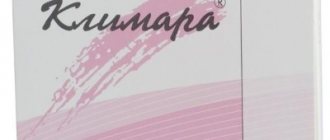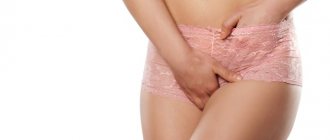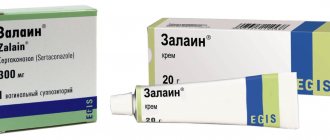Pharmacodynamics and pharmacokinetics
Iodine-containing antiseptic . The antiseptic effect is provided by molecular iodine. During the treatment of the skin, the resorptive effect of iodine is manifested: it enhances metabolism , accelerates dissimilation , has a proteolytic effect, and takes part in the process of synthesizing the hormones T3 and T4 .
Under the influence of ethanol , the excretion of iodine slows down and its irritating effect on tissues decreases. A bactericidal effect against gram-positive flora, streptococci , Protea , Escherichia coli and most gram-negative bacteria .
The drug affects the vital activity of yeast and pathogenic fungi , and has a detrimental effect on the spores of anthrax . Pseudomonas aeruginosa is resistant to iodine . The medicine is low-toxic.
Composition of the drug
The drug Iodinol consists of three main components:
- An alternative to regular iodine is potassium iodide.
- Molecular iodine.
- Polyvinyl alcohol.
The main advantage of the drug is that the molecular iodine and potassium iodide contained act directly on the pathogens of the disease, that is, the drug effectively destroys fungal colonies, thus preventing their spread.
Potassium iodite acts quite gently and does not lead to burns of the mucous membrane, as happens when using regular iodine. Thus, Iodinol for thrush is the most reliable and safer drug in comparison with other medications for this disease.
Indications for use
The use of Iodinol in gynecology is limited to antiseptic treatment of the surgical surface.
For myalgia , injuries, infectious and inflammatory lesions of the skin, the medication is used externally.
For varicose and trophic ulcers , chemical and thermal burns of I-II degree, purulent otitis media , chronic tonsillitis and atrophic rhinitis , it is used topically. For tertiary syphilis atherosclerosis , it is possible to use the medicine internally.
How to know when it’s time for Iodinol: a little about thrush
This disease is known to everyone, as many of us experience it already in the first days of life. At the same time, women are 4 times more susceptible to infection than men, but this does not mean that the stronger sex does not get sick. Anyone can experience a fungal infection. Its most common course options are:
- Vaginal candidiasis in women;
- Candidiasis balanoposthitis in men;
- Thrush in newborns;
- Candidal stomatitis;
- Candidal infection;
- Candidiasis of the skin;
- Nail mycosis in children and adults;
- Candidal urethritis;
- Intestinal candida infection;
- Generalized candidiasis.
Thrush is a disease that accompanies a decrease in immunity, hormonal imbalances, the presence of other concomitant diseases of various natures, or an irresponsible attitude to hygiene. Treatment requires finding out the reasons why the infection developed. Therapy will only be effective if factors that contribute to thrush have been eliminated or minimized. At the same time, it is worth paying attention to increasing the potential of protective mechanisms and taking vitamins and minerals.
The symptoms of thrush can be quite striking. Its most characteristic features are:
- Itching and burning;
- The presence of a white coating (its structure resembles cottage cheese);
- Inflammation, swelling, redness and/or rash in the affected areas.
10-15% of people have no symptoms of thrush at all. They are its carriers.
Symptoms may vary depending on the course and location of the fungus. So, if thrush develops in the genital area, but patients complain of disorders in the sexual sphere: pain during intimacy along with an increase in libido due to irritation by fungal agents in the intimate area.
More than 75% of women have experienced vaginal thrush at least once in their lives, and half have had repeated episodes of the disease.
Unfortunately, fungal infections tend to come back again. Relapses most often develop in people with weakened immune systems, due to poor nutrition (too much glucose in the body), sexual contact (including oral and anal intercourse) with infected people.
It is not worth treating thrush without the participation of a professional. The fungi that cause it are very insidious in nature. They easily develop resistance to drugs that are used incorrectly. The doctor selects the dosage of medications individually, drawing up a scheme taking into account all the nuances of a particular case, the characteristics of the body and the course of the disease. If such recommendations are followed exactly, then in most cases thrush recedes, and in good health it never returns.
By the way, there are cases of self-healing, when a person’s strong immunity overcomes the disease on its own. Most often this happens with thrush in men on the penis, since in these areas of the mucous membrane it is difficult for candida to secure its position. Self-healing should not be confused with temporary remission of thrush.
Among the main preventive measures are a responsible attitude towards one’s health, nutrition and hygiene, selective sexual intercourse, and absence of stress. You need to understand that even frequent colds can cause the activation of fungal flora.
Contraindications
contraindications are known :
- hypersensitivity to iodine ;
- history of allergic responses.
Iodinol can be prescribed to children only from 5 years of age.
For urticaria , chronic pyoderma , adenoma , pulmonary tuberculosis , acne , furunculosis , nephrosis , nephritis , hemorrhagic diathesis, taking the medication orally is contraindicated.
Male and female disease
Despite the fact that thrush is considered primarily a female disease, a significant part of these factors threatens its development in men. Candidiasis lesions in males usually manifest themselves in the form of balanitis and balanoposthitis, often developing into inflammation of the urethra and bladder. The disease is accompanied by itching, a whitish cheesy coating with an unpleasant odor covering the surface of the glans penis and foreskin, and difficult and painful urination. When cystitis is caused by a fungus, the urine becomes cloudy, an admixture of blood appears in it, and in the case of a secondary infection, pus appears.
Candidiasis is not a sexually transmitted disease, but in some cases highly pathogenic strains of Candida albicans and Candida tropicalis can be sexually transmitted. At the same time, the carrier of the disease does not always suffer from it himself - if his immunity is strong enough to suppress fungi, they do not multiply in his body, being present only as a normal element of the microflora. Therefore, if symptoms of thrush appear in one of the regular treatment partners, both should undergo a course of antifungal therapy, otherwise re-infection and relapse are possible.
Side effect
Taking the solution orally causes increased sweating , rapid heartbeat, nervousness , insomnia , diarrhea (typical for older people), and allergic responses. Application to skin may cause irritation.
Long-term treatment of extensive wound surfaces can lead to iodism (salivation, urticaria, acne, Quincke's edema , lacrimation).
Contraindications for treatment
Like any medicine, this drug has its own list of contraindications. The medicine is not recommended to be used for:
- Acute and chronic diseases of the kidneys and urinary system. If a woman has a history of nephritis, pyelonephritis or nephrosis, then Iodinol can cause renal failure.
- The medicine is not recommended for open forms of pulmonary tuberculosis and clinical manifestations of pulmonary emphysema.
- The drug is prohibited in patients suffering from hemorrhagic diathesis and chronic disorders of the integrity of the skin.
- Iodinol is not prescribed to pregnant women, regardless of trimester and during breastfeeding.
It should be remembered that this medicine contains iodine salts and can negatively affect the functioning of a woman’s endocrine system, therefore, before starting appropriate treatment, you should definitely obtain consultation and permission from an endocrinologist and gynecologist.
Instructions for use of Iodinol (Method and dosage)
Locally, Iodinol is used to lubricate the tonsils, apply bandages, and for rinsing.
For the treatment of chronic tonsillitis, regular washing of the supratonsillar spaces and tonsils is recommended.
How to gargle with Iodinol: single dosage – 50 ml, 4-5 rinses daily for three days.
How to dilute Iodinol for gargling : add a solution of the drug to 100 ml of boiled water until the water turns dark yellow. The resulting solution is suitable for rinsing.
Treatment of chronic purulent otitis : for epitympanitis, the attic is washed, and for mesotympanitis, a solution is instilled (5-8 drops per procedure). Duration of therapy is up to 4 weeks.
Therapy for chronic atrophic rhinitis recommends first softening and removing the crusts, and then spraying the nasal cavity and nasopharynx (2-3 times a week, course - 3 months).
For ulcers ( varicose , trophic ), gauze bandages soaked in the solution are applied. Dressing is carried out 2 times a day, each time soaking the gauze with a solution, but without removing it. A week later, a local bath is prescribed, and procedures with gauze bandages are continued until complete healing.
Treatment of infected burns and purulent wound lesions includes the application of a special loose gauze bandage soaked in the drug.
How to treat thrush with Iodinol
Given the virtual absence of harmful local effects, doctors use this medicine in a variety of forms. The effect of the therapy depends entirely on how the medicinal solution is prepared.
How to breed for treatment
Most labels for Iodinol do not provide clear guidance on this issue. The most experienced gynecologists advise diluting the drug in warm water in a 1:1 ratio. The water should be at room temperature, since iodine almost completely decomposes in boiling water.
To treat the mucous membrane, in the presence of itching or foul-smelling discharge, it is recommended to mix a tablespoon of the medicine with 250 grams of water and insert it into the vagina using a syringe. If the solution is prepared correctly, then the risk of causing a burn to the mucous membrane will be minimal.
Douching with Iodinol and its features
There are no special differences in the method of treating the vagina with the drug in question. After consulting a doctor, prepare a medicinal solution at home.
Before starting the procedure, the woman should try to remove as much discharge and mucus as possible from the cavity. After this, using a syringe, an aqueous solution of Iodinol is evenly applied to the mucous membrane, while trying to cover as large an area as possible.
Iodinol price, where to buy
The price in Ukraine for this medication is 50 UAH. You can buy Iodinol at the pharmacy.
- Online pharmacies in RussiaRussia
Pharmacy Dialogue
- Iodinol (100ml bottle) Tula FF
30 rub. order - Iodinol (bottle 100ml) Samaramedprom
36 RUR order
How is the douching procedure performed?
If a doctor prescribes treatment with such a drug, then you must first prepare the correct solution for douching. To do this, you need to dilute Iodinol with warm boiled water in equal proportions.
Immediately before the procedure, you need to thoroughly wash your genitals (using intimate hygiene gel). You need to make sure that the solution is not too hot or cold; the best option is water at room temperature.
It is very important to choose a position in which it will be most comfortable to douche. Gynecologists recommend performing the procedure in a sitting position, with your legs spread wide. But this can also be done while lying down, with your shins thrown over the bathtub. Sometimes it is more convenient for women to perform such manipulations while sitting on the toilet. Everything here is very individual, so each representative of the fairer sex must determine for herself how she will be as comfortable as possible.
After choosing the desired position, you need to take a syringe, fill it with the prepared solution (250–300 ml) and smoothly insert the bulb tip into the vagina. This must be done with great care so as not to accidentally damage the mucous membranes or bladder. When part of the device goes inside about 5–6 cm, you need to pour the Iodinol solution into the intimate organ. In this case, it is necessary to ensure that the drug does not reach the cervical area.
Douching for thrush in women should not cause pain. If discomfort appears, then you need to interrupt the manipulations. Then you should relax, wait 1-2 minutes and continue the procedure. It is not recommended to make too sharp or faster movements, so as not to harm the vaginal tissues.
After douching is completed, you should relax and lie on the bed for 25–30 minutes. It is usually recommended to use Iodinol for such procedures for 7 days. But sometimes doctors may prescribe a different course of therapy. Therefore, it is very important not to use the drug without consulting a gynecologist. Quite often, specialists prescribe a number of other remedies so that the therapy is comprehensive and gives positive results quickly.
Properties of iodinol
- The drug has a pronounced antifungal and antibacterial effect.
- Iodinol is an antiseptic and blocks the proliferation of bacteria and fungi. It can fight streptococcal infections and staphylococci, therefore it is often used for inflammatory diseases of the respiratory tract, otitis media, external damage to the skin, ulcers, and suppuration.
- When using Iodinol, the immune system does not suffer, because the use of natural preparations can only improve the body's condition.
If you have problems with the thyroid gland, Iodinol is prohibited
It should be noted that the use of Iodinol is contraindicated in women with thyroid diseases and hypersensitivity to drugs containing iodine. Therefore, before starting treatment for a fungal disease with Iodinol, it is necessary to undergo examination, in particular by an endocrinologist, to exclude possible diseases of the endocrine system. Also, the use of drugs containing iodine can cause allergic reactions, skin rashes, and an unpleasant taste in the mouth. You should not use Iodinol if you are particularly sensitive to the components of the drug.
The drug is also not prescribed during pregnancy and breastfeeding; it cannot be used in the treatment of children under six years of age.
In cases where Iodinol is prescribed for the treatment of thrush, the drug can be used in the form of a solution with which women are douched.
Indications and contraindications
Like any other medicine, Iodinol has its own indications and contraindications for use. Let's look at them using the example of Povidone-iodine vaginal suppositories. So, the indications include:
- treatment of vaginitis (mixed and nonspecific);
- candidiasis;
- trichomoniasis;
- genital herpes;
- as a prevention of infectious and inflammatory complications before gynecological interventions (artificial termination of pregnancy, installation and removal of an intrauterine device, diathermocoagulation of the cervix, hysterosalpingography, etc.).
The manufacturer of the drug lists the following conditions as contraindications:
- hypersensitivity to iodine preparations;
- thyroid adenoma;
- hyperthyroidism;
- chronic renal failure;
- simultaneous use of radioactive iodine;
- Dühring's dermatitis herpetiformis;
- pregnancy and lactation;
- children's age (up to 8 years).
Composition of the solution Iodinol
The composition of Iodinol (100 ml) includes:
- iodine (0.1 g);
- potassium iodide (0.3 g);
- polyvinyl alcohol (0.9 g);
- water (up to 100 ml).
The drug has a characteristic odor of iodine and a dark blue color, which is why it received the unofficial name “blue iodine”. When shaken, the solution foams.
Iodinol is sold in pharmacies in bottles of various sizes from 25 ml to 250 ml, glass and plastic. For hospitals, the drug is produced in bottles up to 5 liters.
The drug for individual use is available in several forms:
- with a stick-tassel;
- with a spray nozzle;
- in bottles without additional accessories.
Use in the treatment of other diseases
Iodinol has instructions for use for thrush. With equal success, the medication is used in the treatment of thrush, trophic ulcers, purulent otitis media, chemical burns, and chronic tonsillitis.
When making a solution for gargling, you need to dissolve 25 grams of the medicine in 0.2 liters of water. The resulting drink is used twice a day.
Iodinol is actively used in the treatment of acute and chronic otitis media. The medicine is instilled into the sore ear, seven drops twice a day. The product can be used for a long time (within 30 days). In this case, you should not dilute the medication.
The principle of action and effectiveness of iodinol
But due to its antiseptic properties, the product is considered an effective antiseptic that prevents the development of pathogenic microflora (among such harmful microorganisms are gram-positive and gram-negative pathogens).
The drug is effective against streptococcal infections, but it is powerless in cases where the causative agent of tonsillitis is Pseudomonas aeruginosa.
In general, this drug shows good results if used to treat affected tissues of the larynx, but the use of this medicine for monotherapy and as the main remedy is not allowed.










